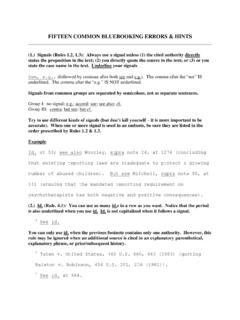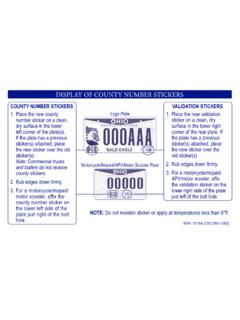Transcription of FIFTEEN COMMON BLUEBOOKING ERRORS & HINTS
1 FIFTEEN COMMON BLUEBOOKING ERRORS & HINTS . (1.) Signals (Rules , ): Always use a signal unless (1) the cited authority directly states the proposition in the text; (2) you directly quote the source in the text; or (3) or you state the case name in the text. Underline your signals. See, , (followed by commas after both see and ). The comma after the see IS. underlined. The comma after the IS NOT underlined. Signals from COMMON groups are separated by semicolons, not as separate sentences. Group I: no signal; ; accord; see; see also; cf. Group III: contra; but see; but cf. Try to use different kinds of signals (but don't kill yourself it is more important to be accurate).
2 When one or more signal is used in an endnote, be sure they are listed in the order prescribed by Rules & Example: Id. at 53; see also Woozley, supra note 24, at 1276 (concluding that existing reporting laws are inadequate to protect a growing number of abused children). But see Mitchell, supra note 95, at 141 (arguing that the mandated reporting requirement on psychotherapists has both negative and positive consequences). (2.) Id. (Rule. ): You can use as many in a row as you want. Notice that the period is also underlined when you use id. Id. is not capitalized when it follows a signal. 1. See id. You can only use id. when the previous footnote contains only one authority.
3 However, this rule may be ignored when an additional source is cited in an explanatory parenthetical, explanatory phrase, or prior/subsequent history. 1. Tuten v. United States, 460 660, 663 (1983) (quoting Ralston v. Robinson, 454 201, 206 (1981)). 2. See id. at 664. (3.) Reporters: Always check the blue pages in the back of the bluebook (Table 1) to ensure that the spacing of reporters is correct. S. Ct. [one space]. F. Supp. [one space]. [no space]. (4.) Pin Cites: All citations must include a pin cite, unless the citation is merely providing the citation for a full case name in text or the citation is a see generally cite in which the entire source makes the point referred to in text.
4 In Tarasoff v. Regents of the University of California,13 the court held .. _____. 13. 551 334 (Cal. 1976). (5.) Page Numbers: When citing multiple pages, give the inclusive page numbers and retain the last two digits of each page, but drop other repetitious digits (Rule (a)). 535-37 1066-79. NOT: 535-537. NOT: 1066-1079. NOT: 535-7. (6.) Order of Authorities: In all footnotes that contain more than one source following a single signal, you must check the citations according to the order of authorities chart in the bluebook (Rule ). For example, several cases following a see signal must be placed in order according to court, chronology, and sometimes alphabetically.
5 All types of sources are subject to this ordering rule, including law review articles and statutes. (7.) Supra & hereinafter: Once an authority (meaning articles, books, etc. but not cases, statutes, constitutions, legislative materials, etc.) has been cited once in full, it is thereafter referred to with a supra cite (Rule ). 23. See Carla S. Copeland, The Use of Arbitration to Settle Territorial Disputes, 67 Fordham L. Rev. 3073, 3075 (1999). * * *. 58. Copeland, supra note 23, at 3077. Hereinafter should be used in the following circumstances (Rule (b)): (1) The authority is too cumbersome to cite with the usual supra form. (2) The supra form would be confusing to the reader, for instance when there is more than one piece by an author in a footnote.
6 In this situation, the hereinafter cite should include the author's last name , followed by a comma and the underlined title of the work, which can be in shortened form. The hereinafter parenthetical immediately follows the first full citation and is enclosed in brackets. 23. See Judith Resnik, The Domain of the Courts, 137 U. Pa. L. Rev. 2219, 2221-22 (1989) [hereinafter Resnik, The Domain of the Courts]; Judith Resnik, Failing Faith: Adjudicatory Procedure in Decline, 53 U. Chi. L. Rev. 494, 518-20 (1986) [hereinafter, Resnik, Failing Faith]. * * *. 67. Resnik, The Domain of the Courts, supra note 23, at 2229. (8.) Case Names and Abbreviations: The abbreviation of case names is governed by Rule Every case name must be checked against the abbreviations chart in the bluebook (Table ) many words in cases can (and should) be abbreviated!
7 Note that in footnotes, words other than the first word in each party's name are subject to the abbreviation rule. In text, however, only words such as Co., Corp., and Inc. can be abbreviated (Rule (c)). 14. Global Engineering Enterprises v. Universal Environmental Building Corporation, .. Becomes: 14. Global Eng'g Enters. v. Universal Envtl. Bldg. Corp., .. Underline case names IN TEXT (no italics) and always give the full case name the first time you cite it. When citing a case name IN FULL, do NOT underline the case name IN THE ENDNOTE. (Rule ). 23. See Bush v. Gore, 531 98, 105 (2000). (9.) Short Cites: A case or statute should be short-cited if it appears within the five previous endnotes.
8 Note that Id. counts as a citation to the case or statute. Otherwise, a full case name or statute citation must be used (Rules & (b)). When using a short cite for a case, underline the part of the case name comprising the short cite (Rule ). 1. Esercizio v. Roberts, 944 1235, 1245 (6th Cir. 1991). 2. Syntax Labs., Inc. v. Norwich Pharmacal Co., 437 566, 568. (2d Cir. 1971). 3. See id. at 570. 4. 28 1292(b) (1994). 5. Stephen Ellmann, Truth and Consequences, 69 Fordham L. Rev. 895, 924-28 (2000). 6. See infra note 88 and accompanying text. 7. See Ellmann, supra note 5, at 899. 8. Syntax, 437 at 570. [Id. short cite appears w/in the previous 5 footnotes, so use the short cite here.]
9 ]. 9. See 28 1292(b). [Statute was cited w/in the previous 5 footnotes, so drop the date.]. 10. Esercizio v. Roberts, 944 1235, 1243 (6th Cir. 1991). [Last cite was 9 cites earlier, so give the full cite.]. (10.) According to the Bluebook, law review article titles are italicized. Underlining also is acceptable and must be used exclusively in the Unified Writing Competition. Ordinary Courier New-12 pt. type for the title of the journal must be used in place of LARGE/SMALL. CAPS. 13. John Czarnetzky, Time, Uncertainty, and the Law of Corporate Reorganizations, 67 Fordham L. Rev. 2939, 2942-43. (1999). See Table 13 in the back of the Bluebook for the correct abbreviations of periodical titles.
10 (11.) Spacing in Endnotes: In endnotes, citation sentences begin one space after a textual proposition. But if you begin a new sentence after a citation, that new sentence will be two spaces after the citation. 34. See Bush, 531 at 103. [two spaces] The Court also discussed the fundamental nature of the right to vote and the equal weight given to each vote. [one space] Id. at 104. (12.) Parentheticals: Try to include parentheticals whenever possible to describe to your reader what the case held or why it is pertinent to the discussion. Try to acclimate the reader and make it very easy for him or her to understand why you are citing to this source as opposed to any other.


